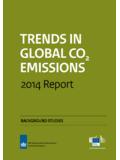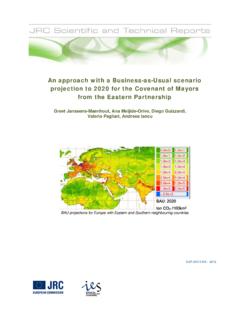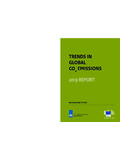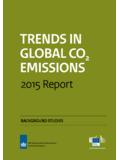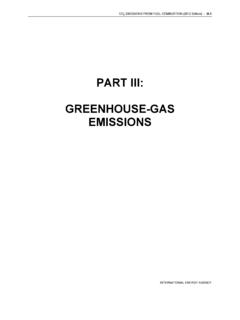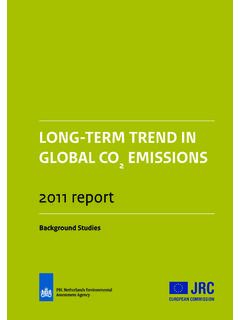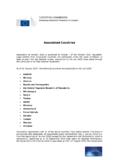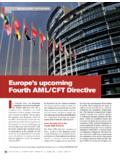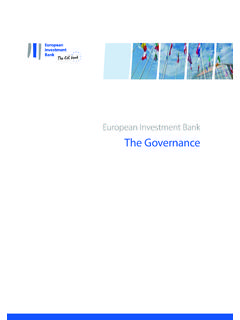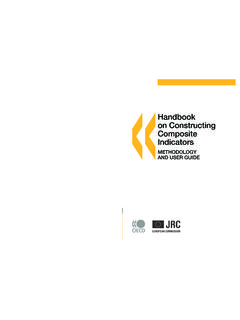Transcription of TRENDS IN GLOBAL CO2 EMISSIONS - Europa
1 TRENDS IN. GLOBAL CO2. EMISSIONS . 2016 Report TRENDS in GLOBAL CO2 EMISSIONS : 2016 report TRENDS in GLOBAL CO2 EMISSIONS : 2016 Report thank P. Boot (PBL), den Elzen (PBL), van Ierland PBL Netherlands Environmental Assessment Agency (EC-DG CLIMA), J. Talkop (EC-DG CLIMA), F. Dentener The Hague, 2016 (EC-JRC), M. Crippa (EC-JRC), B. Koffi-Lefeivre (EC-JRC), PBL publication number: 2315 S. Calsamiglia-Mendlewicz (EC-JRC), R. Quadrelli (IEA), European Commission, Joint Research Centre, A. Jones (IEA), Peters (CICERO), Y. Meijer (ESA) and Directorate Energy, Transport & Climate A. Iancu (EC-JRC) for their review and suggestions and JRC Science for Policy Report: 103428 E. Schaaf (EC-JRC) and M. Duerr (EC-JRC) and D. Guizzardi (EC-JRC) for support on the data. We thank the IEA, USGS. Corresponding author and WSA for providing recent statistics. Editing Authors PBL and EC-JRC. Jos Olivier (PBL), Greet Janssens-Maenhout (EC-JRC), Marilena Muntean (EC-JRC), Jeroen Peters (PBL) Graphics PBL Beeldredactie Responsibility PBL Netherlands Environmental Assessment Agency Production coordination and English-language editing European Commission, Joint Research Centre (EC-JRC) PBL Publishers Acknowledgements Layout This report was drafted with input from many colleagues, Xerox/OBT, The Hague gathered over several years.
2 The authors would like to About this publication This publication can be downloaded from: or EMISSIONS . Parts of this publication may be reproduced, providing the source is stated, in the form: Olivier , Janssens-Maenhout G., Muntean M. and Peters (2016), TRENDS in GLOBAL CO2 EMISSIONS ; 2016 Report, The Hague: PBL Netherlands Environmental Assessment Agency; Ispra: European Commission, Joint Research Centre. This CO2 report 2016 is one in a series of annual publications by PBL Netherlands Environmental Assessment Agency and the European Commission's Joint Research Centre (JRC). After publishing web reviews in 2007 and 2008, the CO2. report series started in 2009, providing up-to-date knowledge on the trend in GLOBAL CO2 EMISSIONS from fossil fuels and cement. CO2 emission estimates were made by PBL and the JRC on the basis of energy consumption data for the 1970 2013 period, published by the International Energy Agency (IEA), and on 2014 2015 TRENDS , published by BP.
3 The estimations are also based on production data on cement, lime, ammonia and steel, as well as on EMISSIONS per country, from 1970 to 2012, from the EMISSIONS Database for GLOBAL Atmospheric Research (EDGAR) version , which was developed jointly by the JRC and PBL. The greenhouse gas EMISSIONS of the EDGAR FT2012 dataset have also been used for the GLOBAL EMISSIONS overviews in the EMISSIONS Gap Reports of the United Nations Environment Programme (UNEP) (2012 2016). All reports are available from and PBL Netherlands Environmental Assessment Agency is the national institute for strategic policy analysis in the field of environment, nature and spatial planning. We contribute to improving the quality of political and administrative decision-making by conducting outlook studies, analyses and evaluations in which an integrated approach is considered paramount. Policy relevance is the prime concern in all our studies. We conduct solicited and unsolicited research that is both independent and scientifically sound.
4 As the European Commission's science and knowledge service, the Joint Research Centre's mission is to support EU. policies with independent evidence throughout the whole policy cycle. Its work has a direct impact on the lives of citizens by contributing with its research outcomes to a healthy and safe environment, secure energy supplies, sustainable mobility and consumer health and safety. Working in close cooperation with policy Directorates-General, the JRC addresses key societal challenges while stimulating innovation through developing new methods, tools and standards, and sharing its know-how with the Member States, the scientific community and international partners. Contents Summary and main findings 4. 1 Introduction 8. Methodology and data sources used 8. 2 Results 12. After a slowdown in growth, GLOBAL CO2 EMISSIONS stalled in 2015 12. Different TRENDS in the largest emitting countries and regions 19. China 19. United States 23. European Union 26. India 30.
5 Russian Federation 31. Japan 32. South Korea 33. Canada 33. Brazil 33. Indonesia 33. Saudi Arabia 34. G20 countries 34. Other remaining countries 34. Comparison of EMISSIONS in the various countries 34. 3 How to mitigate CO2 EMISSIONS from energy supply and consumption 46. Introduction 46. TRENDS in GLOBAL fossil-fuel consumption and fuel mix 47. TRENDS in renewable energy sources 50. TRENDS in nuclear energy 55. Annex 1 Methodology and data sources 60. Methodology and data sources over the 2012 2015 period 60. Dataset on biofuel use in road transport 62. Other sources of CO2 EMISSIONS : forest and peat fires and post-burn decay 63. Annex 2 Other TRENDS and CO2 results 64. CO2 EMISSIONS from oil and gas production 64. CO2 EMISSIONS from cement production (non-combustion) 64. CO2 EMISSIONS from iron and steel production 67. CO2 EMISSIONS from other industrial sources 67. Annex 3 Data quality and uncertainty 68. Annex 4 GLOBAL and regional temperatures 72. List of abbreviations and definitions 74.
6 References 76.. Summary and main findings The year 2015 was a historic year. First, 2015 was the GDP growth in China of about 7%, down from a decade of hottest year since records began in 1880. Moreover, official annual GDP growth figures of about 10%, on the 16 warmest years recorded are in the 1998-2015 average, until 2013. However, in 2015 GLOBAL CO2 EMISSIONS period. Second, top emitter China started to curb its became decoupled from GDP, as GLOBAL GDP continued to carbon dioxide (CO2) EMISSIONS in 2015. China and the grow by A more structural shift away from carbon- United States reduced their EMISSIONS by and , intensive activities, particularly in China but also in the respectively, compared to 2014. EMISSIONS in the Russian United States and other countries, contributed Federation and Japan also decreased, by and , considerably to this trend. respectively. However, these decreases were counter . balanced by increases in India of , in the European Union, where EMISSIONS increased by , and by Changes in fossil fuel mix and increased EMISSIONS in a large group of the smallest countries.
7 Third, 2015 closed with the adoption of the renewable energy landmark Paris Agreement on Climate Change by 194 countries and the European Union. GLOBAL primary energy consumption increased in 2015 by , which was similar to 2014 but well below the As a result of these changes in national emission totals, 10-year average of , even though fossil fuel prices fell GLOBAL CO2 EMISSIONS from fossil fuel combustion, cement in 2015 in all regions. In 2015, coal consumption decreased, production and other processes decreased in 2015 by globally, by , while GLOBAL oil and natural gas Taking into account the uncertainty in the trend we consumption increased by and , respectively. conclude that, in 2015, GLOBAL CO2 EMISSIONS for these These shifts in fossil fuel consumption also affected the sources stalled. This conclusion confirms that the fuel mix. The largest decreases in coal consumption were slowdown in the growth in GLOBAL CO2 EMISSIONS from seen in the United States and China, partly counterbalanced fossil fuel combustion in the last years was not random, by increases in India and Indonesia.
8 For oil consumption, but due to structural changes in the economy, GLOBAL the largest increases were in China, India and United energy efficiency improvements and in the energy mix of States. The GLOBAL increase in the use of natural gas was key world players, as anticipated in previous CO2 reports mainly due to increased consumption in the United States by Olivier et al. (2015, 2014). It also is in line with the and the European Union, with smaller increases seen in assessments of the GLOBAL Carbon Project (GCP, 2016) and Iran and China. IEA announcement (2016a). The production of nuclear energy increased by and hydroelectricity by ; resulting in respective shares of and in total GLOBAL power generation, and Stalling of GLOBAL EMISSIONS in 2015 and in GLOBAL primary energy consumption. In 2015, significant increases of were observed in The stalling of GLOBAL EMISSIONS is no surprise as the other renewable electricity sources, notably wind and declining growth in annual EMISSIONS continued over the solar energy.
9 With double-digit growth for the 12th year past three years: in 2013; then in 2014, and in a row, these now provide almost of GLOBAL power further down to ( ) in 2015. In 2013 and 2014, generation, close to a doubling over the past five years the slower emission growth was not so much a reflection ( in 2010). Their share in 2015 increased to of of slower GLOBAL GDP growth, which continued to increase total GLOBAL primary energy consumption, also doubling by about 3%, but rather was associated with lower annual their share since 2010. 4 | TRENDS in GLOBAL CO2 EMISSIONS : 2016 report . The remaining two thirds of GLOBAL power generation was Structural changes towards less generated by fossil-fuel-fired power stations, which is 1 percentage point down from 2014 and the lowest share carbon-intensive activities in China since 2002. The share of fossil fuel in GLOBAL energy consumption was 86% in 2015. An important reason for the stalling of GLOBAL CO2. EMISSIONS is the change in the world's fossil-fuel use due to the structural change in the economy and in the energy The G20 and the six largest emitting mix of China.
10 For the first time since 2000, China's CO2. EMISSIONS decreased, by , and its per capita CO2. countries (including the European EMISSIONS went down by Although China, generally, Union) in total, emits twice as many CO2 EMISSIONS as the United States, its per capita CO2 EMISSIONS ( tonnes CO2/cap). In 2015, the five largest emitting countries and the remain below half of those in the United States ( tonnes European Union, which together account for two thirds of CO2/cap). While China's EMISSIONS over the 2002 2011. total GLOBAL EMISSIONS , were: China (with a 29% share in period, on average, increased by 10% per year, the recent the GLOBAL total), the United States (14%), the European average annual growth (between 2011 and 2015) was Union (EU-28) (10%), India (7%), the Russian Federation 3% per year. This reduced growth rate and even decline in (5%) and Japan ( ). The 2015 changes within the group EMISSIONS in 2015, was mainly due to a decrease in of 20 largest economies (G20), together accounting for coal consumption and a 1 percentage point increase in the 82% of total GLOBAL EMISSIONS , varied widely, but, overall, share of non-fossil fuel in primary energy consumption.
